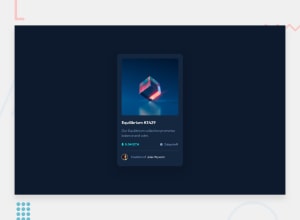
Design comparison
Solution retrospective
Hi!
This is my solution of NFT preview card component, with the Frontend Mentor.
I started to use flexbox so often, I don't know if it's proper. Please let me know, after reviewing the code ;)
After this project I started to:
- understand better process of matching the picture to the container
- feel more comfortable with the clamp function
- also started to feel more comfy with the scale, translate, positioning
Don't know if there is maybe better idea to achive hover effect(the eye, and cyan background color) on the NFT picture. If you have one, please share it with me!
Any words on how to improve the code and simplify it are welcome. Thank You!
Community feedback
- @SheGeeksPosted almost 2 years ago
Great work on achieving the design, Wedrussowo! Here are a few tips I have regarding your code that I hope can be helpful now and down the road.
As a rule of thumb,
headershould always be outside of themaintag. It's best practice to put it right abovemain. The code you've written inheaderwould be more appropriate for adiv.Headeris for nav links and introductions. This is an easy fix in your code - just changeheadertodiv. It shouldn't break anything to make this simple change right now.Take some time to dig into semantic HTML structures for best practices. Here's official documentation about
mainwith a code example and a here's a visual of a typical webpage structure with these tags. This challenge doesn't really require a header, but other challenges will.As for your flexbox concerns, you can remove Flexbox on the
.icon-viewclass and create a new ruling specifically for the icon with the following values to center it again:position: absolute; top: 50%; left: 50%; transform: translate(-50%, -50%); width: unset;When using absolute positioning, you don't need flexbox. You may have to unset the width on the icon to reduce its size because you applied
max-width:100%to all images in yourheaderwithin.main-picture img. If you only target the first image instead of all images you won't needwidth:unset.It's not uncommon to use Flexbox a lot. I find that the better I structure my code, the less I have to turn to flexbox. Maybe in a future challenge you can also practice using CSS Grid, which is just as powerful as flexbox.
Hope the feedback and links are helpful. Keep coding! :)
Marked as helpful0@WedrussowoPosted almost 2 years ago@SheGeeks
First of all, thanks for the tips.
I tried with your code and finally achieved the same effect as with flexbox.
Here's the code, that allowed me to get this effect:
.main-picture a { position: absolute; min-width: 100%; min-height: 100%; transition: all 0.7s; } .main-picture:hover a { background-color: hsla(178, 100%, 50%, 0.50); transition: 0.25s; } .main-picture:hover .icon-view { opacity: 1; transition: .25s; } .icon-view { position: absolute; top: 50%; left: 50%; transform: translate(-50%, -50%); width: unset; opacity: 0; transition: 0.7s ease-out; }Also, I had to remove
class="icon-view"from the<a>tag and add it to<img>tag instead.It was a very good lesson for me. I understood better position absolute, and now I am more conscious on how to prevent unwanted inheritance in the future. But overall, definitely easier was to use flexbox in this case, at least for me. Maybe I complicated it to much, I don't know if this can be achived even easier without flexbox, but I tried my best!
I also changed the
<header>to<div>, like you said.Thank You very much for the feedback! Have good day. :)
0
Please log in to post a comment
Log in with GitHubJoin our Discord community
Join thousands of Frontend Mentor community members taking the challenges, sharing resources, helping each other, and chatting about all things front-end!
Join our Discord
